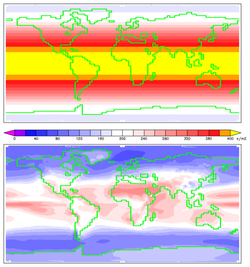Solar irradiance (nonfiction): Difference between revisions
(Created page with "'''Solar irradiance''' is the power per unit area received from the Sun in the form of electromagnetic radiation in the wavelength range of the measuring instrument. Irradianc...") |
|||
| (3 intermediate revisions by the same user not shown) | |||
| Line 1: | Line 1: | ||
'''Solar irradiance''' is the power per unit area received from the Sun in the form of electromagnetic radiation in the wavelength range of the measuring instrument | [[File:Insolation.png|250px|thumb|Annual mean insolation at the top of Earth's atmosphere (TOA) and at the planet's surface.]]'''Solar irradiance''' is the power per unit area received from the Sun in the form of electromagnetic radiation in the wavelength range of the measuring instrument. | ||
Irradiance may be measured in space or at the Earth's surface after atmospheric absorption and scattering. | |||
It is measured perpendicular to the incoming sunlight. | It is measured perpendicular to the incoming sunlight. | ||
| Line 9: | Line 9: | ||
The solar constant is a conventional measure of mean TSI at a distance of one astronomical Unit (AU). | The solar constant is a conventional measure of mean TSI at a distance of one astronomical Unit (AU). | ||
Irradiance is a function of distance from the Sun, the solar cycle, and cross-cycle changes. | Irradiance is a function of distance from the Sun, the solar cycle, and cross-cycle changes. Irradiance on Earth is also measured perpendicular to the incoming sunlight. | ||
Insolation is the power received on Earth per unit area on a horizontal surface. | Insolation is the power received on Earth per unit area on a horizontal surface. It depends on the height of the Sun above the horizon. | ||
== In the News == | |||
== | <gallery mode="traditional"> | ||
File:Sunspots.jpg|link=Sunspot (nonfiction)|[[Sunspot (nonfiction)|Sunspots]] proud to stop solar irradiance at the source. | |||
File:Light 1943.jpg|link=Light (nonfiction)|War-era [[Light (nonfiction)|light rationing]] now a dim memory. | |||
</gallery> | |||
== Fiction cross-reference == | == Fiction cross-reference == | ||
| Line 21: | Line 24: | ||
* [[Sunspotter]] | * [[Sunspotter]] | ||
== External links | == Nonfiction cross-reference == | ||
External links: | |||
* [https://en.wikipedia.org/wiki/Solar_irradiance Solar irradiance] @ Wikipedia | * [https://en.wikipedia.org/wiki/Solar_irradiance Solar irradiance] @ Wikipedia | ||
Latest revision as of 22:25, 23 June 2016
Solar irradiance is the power per unit area received from the Sun in the form of electromagnetic radiation in the wavelength range of the measuring instrument.
Irradiance may be measured in space or at the Earth's surface after atmospheric absorption and scattering.
It is measured perpendicular to the incoming sunlight.
Total solar irradiance (TSI), is a measure of the solar power over all wavelengths per unit area incident on the Earth's upper atmosphere.
The solar constant is a conventional measure of mean TSI at a distance of one astronomical Unit (AU).
Irradiance is a function of distance from the Sun, the solar cycle, and cross-cycle changes. Irradiance on Earth is also measured perpendicular to the incoming sunlight.
Insolation is the power received on Earth per unit area on a horizontal surface. It depends on the height of the Sun above the horizon.
In the News
Sunspots proud to stop solar irradiance at the source.
War-era light rationing now a dim memory.
Fiction cross-reference
Nonfiction cross-reference
External links:
- Solar irradiance @ Wikipedia


